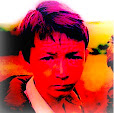The answer that my grand teacher would always give to this question was, “Zen is very simple. What are you?” In this world today, as it has been since human beings began to discriminate and to think, we all began searching for satisfaction outside of ourselves; however, because it seems almost counter-intuitive very few of us ever seek to find happiness within ourselves. Listening to typical conversations we hear others speak of this thing that is labeled “I.” Also, if we have enough internal witness and we listen to our own speech it may surprise us how many times we also use the word “I’ in our conversations. We all talk about this “I” as if it had a separate self, as if this “I” were somehow existent outside of us. We say things like, “I want this,” or “I am like this” but how many of us truly understand this “I” of which we speak, and where does our “I” come from?
In Zen we sometimes ask, “before you were born, before your mother and father conceived you, what was your original nature?” Along these same lines we might ask; when we die, where will we go? If we can sincerely ask ourselves, ‘What am I?’ Eventually we will run into a wall where all thinking is cut off. In our Zen Lineage we call this ‘don’t know;’ however, this state of perception is not exclusive to Zen and other traditions call this state by different names. Christians may call it Christ Consciousness, Jews may call it, YHWH, Daoists might call it the Great and Ineffable Dao, the great twentieth Century Zen teacher Shunryu Suzuki Roshi called it Beginner’s Mind, consequently each path has a separate name for this one state of mind. So, Zen practice is about keeping a don’t-know mind always and everywhere.
when walking, standing, sitting, lying down, speaking,
being silent moving, being still...
at all times, in all places, without interruption–what is this?
one mind is infinite kalpas. Zen Master Seung Sahn
We define meditation in Zen as maintaining a don’t-know mind when bowing, chanting, as well as during seated meditation. Yet, for us in this modern twenty first century it is highly important to keep this don’t know mind every minute of our waking life. There are no special forms of existence or places that will take us out of our current situation or condition; this is the place where we try to escape reality by using drugs, alcohol, video games, the company of others, etc. In and of themselves, these actions are not good or not bad, it is just that it all boils down to a simple question. “Do you control your thinking, or does your thinking control you?” For most of us we have a constant dialog going on in our heads, but who is it that we are talking with? We create this separation inside our own heads. If we can stop this endless train of thoughts, this constitutes what we call formal Zen practice, and it isn’t what we think. We may think that we must meditate, or go off to a mountain top in silence to find ourselves; but Buddha taught that if we are ever to wake up to our own humanity it must be in this very moment. By keeping a don’t know mind when we are doing something, we can just do it. When driving, we just drive; when eating, we can just eat; when working we can just work.
Eventually our don’t know-mind will become clear. Then when we see the sky, there is only blue—when we see the tree, there is only green. Our mind becomes like a clear untarnished mirror—if red appears the mirror reflects red; if white appears the mirror reflects white. If a hungry person arrives, we can give some food; if a thirsty person arrives, we can give something to quench their thirst. In the end there is no desire for myself, only for all sentient beings. This mind is already enlightened; it is what we call Great Love, Great Compassion, and the Great Bodhisattva Way. Zen is very simple, it is not difficult!
Posted by Rev. Paul Dōch'ŏng Lynch Zen Mirror: What is Zen?
Understanding is the essence of love.






























.png)







.jpg)





,+Los+agachados,+1934.jpg)






























































